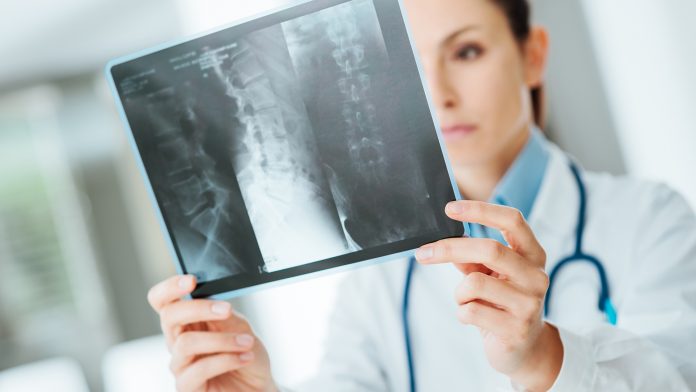
The NHS ADOPT study has initiated an automated AI process for identifying patients with spine fractures.
Leveraging the power of Artificial Intelligence, the Nanox.AI HealthVCF programme is now scrutinising thousands of hospital computed tomography (CT) scans to identify individuals at risk of spine fractures swiftly.
Subsequently, these patients are fast-tracked for bone health assessment by a dedicated NHS osteoporosis team.
The impacts of osteoporosis
Osteoporosis, a condition in which bones become more porous and fragile, often goes undetected until a fracture occurs.
Such fractures can be an initial sign of the condition when they manifest in individuals over 50. Identifying at-risk individuals early is crucial, as prompt diagnosis can lead to effective osteoporosis treatments that prevent the agony of broken bones.
Left untreated, osteoporosis can result in a hunched back and gradual loss of height. Furthermore, spine fractures frequently go unnoticed when they are mistaken for ordinary back pain.
Adopting a new strategy for spine fractures
The ADOPT study, a collaborative effort between the University of Oxford, Addenbrooke’s Hospital in Cambridge, medical imaging technology company Nanox.AI, and the Royal Osteoporosis Society, has been funded and supported by the National Institute for Health and Care Research (NIHR) and NHS England.
The project is aimed at testing an innovative AI programme designed to identify spine fractures within CT scans automatically.
Every year, more than three million people in the UK undergo CT scans that encompass the spine. However, since these scans are primarily conducted for other diagnostic purposes such as lung, bowel, or disease monitoring, spine fractures are often overlooked.
Remarkably, over 5% of these CT scans exhibit osteoporotic spine fractures, making the ADOPT study all the more crucial.
How does HealthVCF work?
Nanox.AI’s HealthVCF Artificial Intelligence programme diligently evaluates all local CT scans to detect spine fractures and promptly notifies specialist teams.
The system has recently identified its first suspected cases of vertebral fractures. According to Daniel Chappell, Clinical Projects Manager at Addenbrooke’s Hospital in Cambridge: “Within the first month of my switching on the Nanox.AI-fracture detection system, several thousand CT scans were processed.
“From 497 alerts made in July 2023, 244 (49%) correctly identified patients with true vertebral fractures. Examining the records of these 244 patients, 170 of them required osteoporosis assessment and treatment.
“While 147 were already scheduled for bone health management using our current spine fracture detection pathways, a total of 23 people found by Nanox.AI’s HealthVCF are now scheduled for a bone health assessment and, hopefully, fracture-preventing treatment.”
Leading the research at the Nuffield Department of Orthopaedics, Rheumatology, and Musculoskeletal Sciences (NDORMS) at the University of Oxford, Professor Kassim Javaid expressed optimism about the project, saying, “Finding and assessing the first patient from the ADOPT study for osteoporosis to improve their bone health and reduce their risk of fracture represents a milestone for the study.
“We hope the positive benefits from using Nanox.AI will significantly change the lives of thousands of patients in the project and potentially hundreds of thousands of lives in the NHS.
“It also represents the fruition of the combined efforts from clinicians, researchers, IT experts, and the teams from Nanox and the Royal Osteoporosis Society, including patients, to implement this novel care pathway into the NHS. We now eagerly await the results of the study in 2024.”
If successful, implementing an AI-enhanced vertebral fracture prevention pathway could revolutionise the identification, assessment, and treatment recommendations for osteoporosis patients, ultimately leading to potential cost savings for the NHS.







